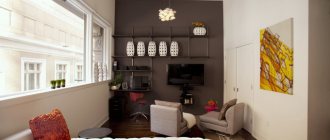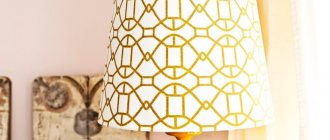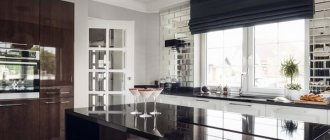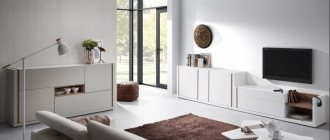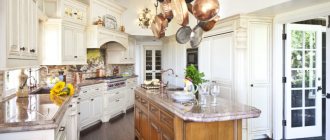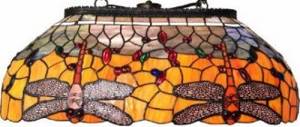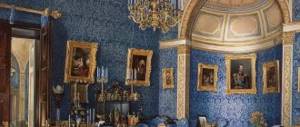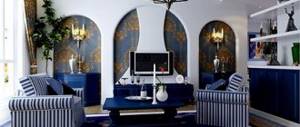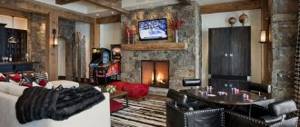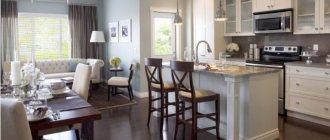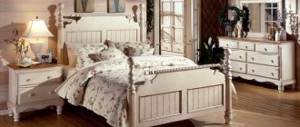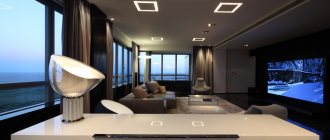A little history
The style itself appeared at the end of the 19th century and became an excellent replacement for the elaborate and bulky Baroque and Rococo. Its appearance became possible thanks to a sharp leap in technology and the transition to mass production of necessary items.
Art Nouveau quickly gained popularity due to its fairly simple decorating process at the time.
However, the style did not last long on the podium and soon ceased to be in demand. One of the reasons for the rapid decline in popularity was the First World War, which required the industry to be transferred to a war footing. There was no time for the beauty of the decoration of the premises.
The second compelling reason was the transformation of initially simple decor into a rather complex style, which, in addition to creative decoration, began to require large financial costs.
By the way, Art Nouveau has quite a few varieties: it was called “Art Nouveau” in French, “Liberty” in Italian, “Tiffany” in American, and “Jugendstil” in German.
However, the modern kitchen design has retained the main features in all its varieties.
Color solutions in the interior
The design of a kitchen in the Art Nouveau style is done in muted tones, since it does not accept too bright and “flashy” colors. Metallized surfaces enhance the interior of a kitchen space in the same way as the white glossy or matte surface of furniture fronts.
The design is developed based on the inadmissibility of excessive diversity. Furniture, flooring and wallpaper should not have intrusive patterns. It is not recommended to use more than three or four primary colors in the interior, otherwise the kitchen will look defiant.
Although there is furniture and finishing materials of various colors on the market, the most popular of them are:
- white and cream;
- yellow and green;
- beige and brown;
- orange and purple.
Each color has a lot of shades and limitations. They can be saturated to a certain extent, but never too bright and harsh. It is recommended to select light-colored furniture and wallpaper for the interior of a small kitchen. A white countertop and white false panel will successfully set off dark facades, and black color in contrast with light or metal inserts will make the kitchen interior stylish and unusual.
Contrasting colors are preferred by self-confident and extraordinary homeowners who want to achieve a lot from life.
Art Nouveau design when choosing a color palette gives freedom to creativity with almost no restrictions. Fashion trends today include white, gray-pink and gray-lilac, muted brown and dark beige paints, as well as light green and red colors in the kitchen interior.
Paintings hung on the walls, flowerpots and lampshades to match the furniture facades, chair upholstery and unusual decorative elements are used as accents in the interior.
But you shouldn’t overload the design of the room with small details - they will bring chaos to the kitchen and clutter it up. And this contradicts the basic principle of modernity, which is neatness and order.
Main characteristics
Of course, modern kitchens in the Art Nouveau style differ from the original, but the originality of the style still distinguishes this design direction from all other options.
Art Nouveau is characterized by the presence of clearly defined geometric shapes with soft curves reminiscent of the delicacy of natural lines, smooth shiny surfaces, unusual combinations of colors, and asymmetry of design.
Living room interior in modern style
To emphasize the Art Nouveau style in a room, one of three principles is used that characterize the depth of immersion in design.
This:
- Radical - when using it, the designer must fully adhere to all the rules for the arrangement of furniture, dishes, and accessories. This method should be a complete copy of the proposed style.
- Large-scale and decorative - when used in a room, several basic elements that characterize this interior should dominate. They add a touch of elegance to the room and flow smoothly from one direction to another.
- Superficial - it is set off by one accent, which serves as the highlight of the room.
The highlight of any style is accessories. In Art Nouveau - these are large floor or expensive small vases, various painted dishes, compositions of various stained glass windows that are in harmony with the overall color scheme. This elegant design will be complemented and emphasized by interesting sculptures, reproductions of famous paintings, jewelry, complemented with precious stones and metals, and exclusive calendars.
Experts recommend that when creating a design yourself, it is better to consult with experienced and knowledgeable people in order to avoid gross mistakes and waste money.
The Art Nouveau style is complex, with certain features and subtleties, so it is necessary to think in advance about the size, design of furniture and accessories, and color scheme.
Characteristics of today's modernity
The interior of the kitchen in the Art Nouveau style has undergone quite a lot of changes. Modern technologies have helped to combine technical progress and the simplicity of natural elements, to combine new technologies and the purity of natural elements, simple ornaments and light lines, reminiscent of an elegant curl of a woman's hairstyle or a curved vine.
Modern style has become much closer to minimalism, moving further and further away from the classical design.
Kitchen renovation in the Art Nouveau style is perfect for a small space where it is important to create a cozy and functional space. This will be helped by the practicality of decoration and furnishings, the presence of the most modern technical equipment, and a minimal amount of textiles and decor.
Glossy surfaces, cheerfully reflecting the sun's rays or rays of artificial lighting, will add a little more space and light, fill the kitchen with a joyful mood, increase appetite and the desire to create.
Characteristics of the Art Nouveau style
Interior design is conventionally divided into two types – classic and modern. Modernism belongs to the second group, characterized by the absence of pretentiousness and overloading of the kitchen with unnecessary items. Kitchen design in the Art Nouveau style is suitable for pedantic people who are scrupulous about order and convenience.
The main distinguishing features of the Art Nouveau style are:
- smooth lines;
- smoothed corners;
- curved shapes;
- oval niches;
- horizontal orientation;
- asymmetry.
The interior in Art Nouveau style looks neat and compact. It fits especially well into small kitchens, visually increasing the space.
The design of a modern style kitchen involves the use of furniture in:
- metal, plastic and glass;
- enamels, films and varnishes;
- monochrome colors;
- built-in equipment;
- smooth and shiny facades;
- minimum decor.
As decorations, choose paintings or printing in a strict frame, as well as kitchen utensils - wine glasses, pots, glass jars of simple shapes, simple flowerpots and much more.
In a modern interior, furniture is arranged in one line, L or U-shaped. For a spacious kitchen, it is quite acceptable to install an island part, used as a working or dining area.
You should not choose finishing materials that are too expensive. They will not feel entirely comfortable in a modern interior.
Linoleum or laminate, ceramic or PVC tiles are suitable for flooring. White paint is recommended for ceilings, regardless of its design. The interior of a kitchen in the Art Nouveau style allows you to install suspended or suspended ceilings, as well as leave them open and simply painted.
When developing a design project, you should be guided by harmonious combinations of colors and interior details. White is a must-have color in the kitchen. Firstly, it does not conflict with any other color. Secondly, it symbolizes cleanliness and order. And thirdly, it refreshes any shades and the room as a whole. White can also contrast beautifully with colored walls or kitchen fronts.
White wallpaper does not have to be painted a different color before painting. The same white paint will do for them.
Modern is universal and suitable for kitchens of various sizes and layouts. There are a huge number of ready-made options for arranging furniture, decorating windows and creating lighting. But the owner has the right to create his own interior, choose the wallpaper he likes and order furniture according to an individual sketch.
Materials for decoration
A traditional kitchen or kitchen-living room in the Art Nouveau style was distinguished by natural materials. However, today such finishing often becomes too expensive a way to decorate a room and is not always suitable for a room where humidity and temperature often change, splashes of water and grease fly.
Beautiful modern kitchens are increasingly using modern materials that perfectly imitate natural surfaces.
Ceiling decoration
The ceiling can be decorated with almost any material. These can be wooden boards or their substitutes (if the size of the kitchen allows you to install such a ceiling decoration), plasterboard sheets with matte paint applied, regular painting or whitewash, suspended ceilings.
You shouldn’t get too carried away with decorating the ceiling: a plain, smooth, matte surface will make it as close as possible to the canons of design.
For a large kitchen, multi-level designs can be used, but they should also be easy to understand.
Furniture and lamps in Art Nouveau style
Special attention is paid to furniture in Art Nouveau style interiors, since they are not only functional items, but also decorative elements. After all, the direction provides for a minimum of decoration, and the furnishings should look expensive, elegant, and impressive. Therefore, with the help of furniture, the space is also decorated.
That is why modern furniture is created from natural materials and must have:
visual beauty and lightness;- rounded corners and smooth lines;
- precise, laconic forms or, conversely, fancy outlines (depending on the specific design idea);
- upholstery with plant motifs;
- bright expressive decorative elements (carvings, inserts of textiles, bone, stone, inlay, etc.).
As for the lamps that illuminate such interiors, they are also part of the decor. Therefore, they should not only shine, but also decorate the interior. Most often, chandeliers, ceiling lamps, sconces, floor lamps and table lamps with shades made of colored glass or lampshades made of expensive (softly folded or tightly stretched) plain (possibly embellished) textiles are used. Glass or crystal pendants serve as additional decoration for such lamps.
Floor decoration
Flooring also offers a wide choice for selecting the necessary elements. Modern flooring can be created from natural boards, ceramic tiles, waterproof laminate or proven linoleum.
The only requirement will be a calm finish. The floor should not have many elements or be variegated. But the color scheme is almost unlimited: the coating can be pure white, greyish, brown and even black. A white kitchen in the Art Nouveau style will look especially unusual with this color.
If it is possible to lay liquid linoleum, also known as a stretch floor, do not be afraid of such an experiment. The glossy surface will give the kitchen a “modern” touch.
Distinctive features of Art Nouveau
Generally speaking, Art Nouveau, as an interior style, is distinguished by several characteristic features:
- A harmonious combination of artistic qualities and utilitarian functions in decoration, furniture and decor.
- The desire to preserve “natural” outlines, abandoning straight lines and angles in favor of natural ones.
- Simplicity, conciseness and organicity as the principles of space design.
- Inspiring floral patterns and elegant floral designs for surface designs.
- Muted colors used as the main shade solutions.
- Frames as the basis of the structural component of the style;
- The presence of enamel, gold backgrounds, mosaics, embossing on brass and/or copper in the finishing.
Moderno means modern. And because of this name, the style is often subject to dual designation. But in fact, despite the nominal “modernity,” the direction has nothing to do with the latest interior trends. This is an absolutely original, easily recognizable style. And that is why today he is again at the peak of fashion. Although those who have decided to go modern in their own home should understand that creating such an environment is an expensive pleasure, requiring high-quality materials, sophisticated technologies and professional artistic solutions.
Window decoration
Curtains for a modern style kitchen should not attract much attention. It is best if their use is limited to a minimum of curtains. And they should be light and airy, not impede the penetration of air and light.
For classic curtains, the principle of asymmetry is used; light folds will help create some feeling of natural negligence and natural chaos.
Modern curtains are represented by Roman and roller designs, which allow you to quickly regulate solar flow; for lovers of minimalism, blinds are used.
Light colors will help not to focus attention on the decoration of window openings; they are often chosen only slightly darker than the wall decoration.
Flowers and polka dots will not be the most competitive design techniques. Plain canvases will look much better.
Lighting
Natural-technological modernity must be well illuminated. For this, natural light penetrating through large windows is used (if possible, window openings are expanded or panoramic glazing is made), and artificial illumination.
A multi-level lighting system should be aimed at the working and dining areas, but at the same time illuminate every corner of the kitchen; dark and dusty corners are not for modernism.
Spotlights, a large central chandelier or additional pendant lamps above the dining table, fluorescent lamps above work surfaces, cozy sconces on the walls, and decorative LED strips will perfectly decorate the interior.
To recreate the natural character of the style, lampshades in the form of simple balls or ovals and plant elements are used.
No. 6. Modern room lighting
Most interior styles dictate an abundance of sunlight and artificial lighting. With modernity it's the other way around. The light here should be dim, warm, cozy . Imagine a sunny day in the forest, when the tree crowns allow some of the rays to pass through, and they softly flood the space. The light should be romantic, and the glare of the sun will help convey the stained glass.
Lighting is multi-level. Let the central element be a forged multi-arm chandelier; its design may include elements made of frosted or colored glass. Instead of the usual chandelier or together with it, you can arrange interesting ceiling lighting by hiding compact lamps behind the ceiling stained glass window. You will be able to fully convey the spirit of the style, even if some other elements cannot be repeated.
In addition to central lighting, wall sconces and table lamps are used. The legs of floor lamps are made of wood or metal, they are distinguished by curved shapes. Lampshades are made from colored glass, fabric, porcelain, and forging elements are used.
Furnishings
Modern furniture has smoothed corners, and a corner kitchen must meet this requirement.
For a large room, a linear or U-shaped layout is used; for a small room, an L-shaped arrangement is more suitable. This will help leave more free space.
Solid wood furniture is perfect for expensive finishing; more modern options look great with furniture made of MDF or chipboard. Glass, plastic, and PVC film are used for finishing facades. All of them will give the kitchen additional shine and lighting, creating a feeling of spaciousness.
Door handles often imitate twigs or narrow leaves of trees. Often the facades are devoid of such decoration; a key mechanism is used to open them.
The smoothness of the doors can be emphasized by a small floral pattern, but it should be small. Open shelf space should be kept to a minimum.
A modular kit would be an excellent option: it will help fill the kitchen with only the necessary cabinets and cabinets, leaving maximum space for movement.
Lunch group
For modernism, they choose a standard round table with the same rounded chairs, a bar counter with high stools, and massive wooden furniture.
Plastic furniture will look great, but not the cheapest. It is often decorated with unusual metal legs, giving the style a special unusualness and attractiveness. In this case, standard legs are replaced with curved elements or elements emanating from the center of the table or chair.
Historical modern
This style is the very first designer Modern. This is how interiors were decorated from the 80s of the 19th century until the First World War. His most striking images were sea waves, climbing plants, large flowers and languid female faces. And he literally opposed the eclecticism that reigned before him in architecture and design.
That Art Nouveau advantageously combined the artistic component with the utilitarian one. A free but functionally sound layout was introduced into the furnishings. Frame structures and new building and finishing materials began to be used, including glass, reinforced concrete, tiles, raw stone, wrought iron and plywood. Textiles began to be actively used in interior design.
It was those who worked during that period, creating and establishing Art Nouveau as a style, who introduced abstract forms into settings - living, “breathing,” graceful, “flying.” At the same time, the usual design boundaries and norms turned out to be broken. No less than a lifestyle of a new society was born.
Appliances
A modern kitchen should bring pleasure, so it is equipped with a large number of modern appliances to make the housewife’s work easier.
When purchasing household appliances, special attention is paid to the versatility of the purchased items. So, a food processor will replace a meat grinder and a separate chopper; a multicooker will be a good way to remove a microwave oven, oven, steamer, or bread maker from the room.
For modernism, they try to select items with a slight bias towards recent antiquity: mechanical knobs and switches, analog controls, imitation brass, nickel, copper.
Color spectrum
The color of a kitchen in the Art Nouveau style is distinguished by its natural naturalness. The basis of the room is made up of light and soft shades of ash, gray smoke, cold winter sky, light brown earth, pearl shells, baked milk, fresh butter, golden mustard.
An example of the ideal color combination for a modern kitchen
Brighter shades will dilute some of the coldness of the kitchen in these rather boring tones. Red, green, and blue colors look great here, but you need to choose them from the natural spectrum. These colors are most often featured in a dining room set, textiles or wallpaper.
However, the golden rule of “three colors” should play a major role when decorating a modern kitchen. Too many different colors can make the kitchen a difficult place to enjoy.
Decor
Everything that is in sight must have a certain meaning. Everything that is devoid of practical value is put away in cabinets and cabinets. The basic rule of minimalism should also work in a modern kitchen.
The decor of such a room is distinguished by restraint. The ideal solution would be wall clocks of simple shapes, laconic vases, matte dishes.
Textiles are used to a minimum, choosing towels and potholders in calm colors, but it is better to replace the tablecloth with cute coasters for hot dishes.
The smoothness of lines and the charming simplicity of finishing, the soft flow of elements and the absence of right angles, floral elements, the use of shiny and smooth surfaces make Art Nouveau design an excellent solution for private houses and city apartments.
The practicality and functionality of each element will help you spend less time on cooking and cleaning the room; refined romance will add real comfort and warmth to the appearance of the kitchen. This photo of a modern style kitchen shows it perfectly.
Two main directions of modernity
In a style such as modern, experts traditionally distinguish two directions:
- constructive;
- and decorative.
Although this division is very conditional. In general, modernism can be “divided” ad infinitum, because over its history this style in almost every country has “overgrown” with national traits, which means it has acquired individuality and originality. Therefore, now we can talk about “Russian” modernism, and about “Austrian” or “Viennese”, as well as “French”, “Italian”, “Belgian”, etc.
In addition, Art Nouveau managed to include many trends and stylistic directions:
- neo-romanticism with elements of Gothic, Romanesque and Renaissance;
- neoclassicism with its appeal to antiquity and classicism;
- rationalism with an obvious predominance of simple forms;
- and irrationalism with its mystical lightness, fantastic lines and elements that are “useless” from a practical point of view.
